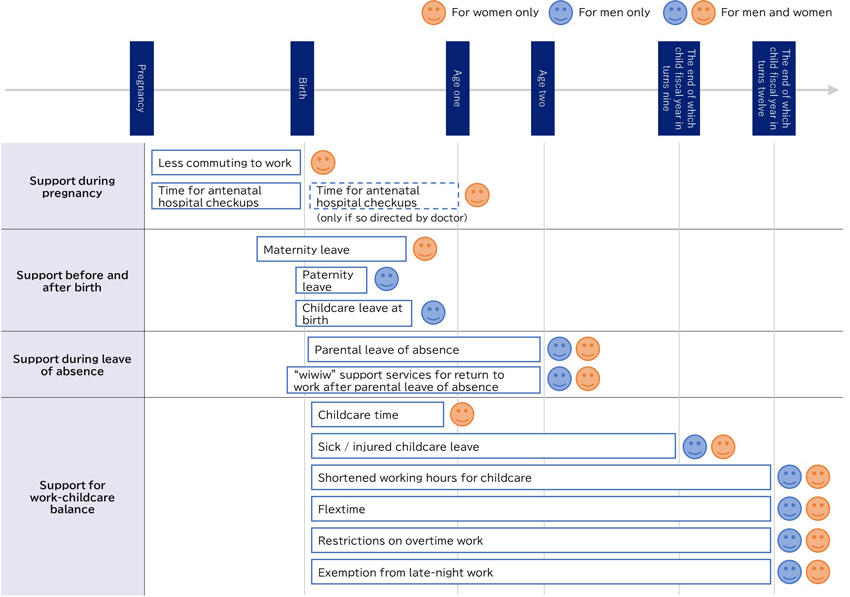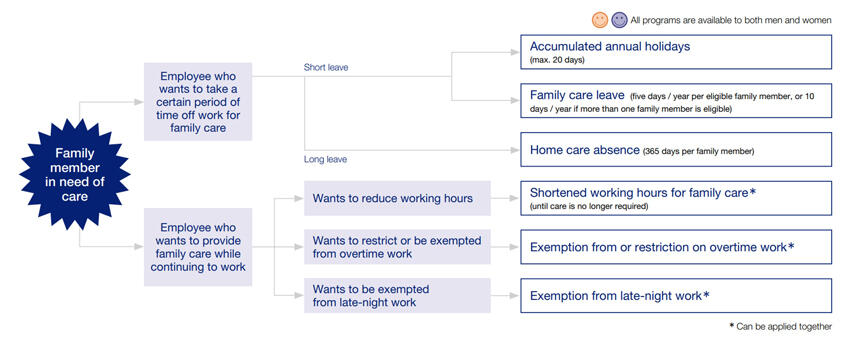- KDDI HOME
 Corporate Information
Corporate Information  Sustainability
Sustainability  Human Resources
Human Resources  Diverse Work Styles
Diverse Work Styles
Diverse Work Styles
Programs That Support Diverse Work Styles
| Program | Content |
|---|---|
| Telework program (Working at home) |
The telework program has been expanded to include all employees so that they can work flexible hours and boost their work efficiency, in addition to scheduling their work around parenting and family care. We have implemented environmental improvements for satellite office work and mobile work.
|
| Variable working hours system | Introduced so that employees can change their prescribed working hours every month or every three months according to their volume of work. This system is also available on a monthly basis to employees requiring shortened working hours due to childcare and/or family care responsibilities. |
| Discretionary work system | Introduced to encourage a work style where the emphasis is placed on high performance achieved in a shorter time. At the end of March 2023, 20% of the eligible employees use this system. |
| Work shift interval rule program | Introduced to raise awareness of a more health-focused work style. The rule stipulates that employees should rest for a minimum of nine hours between the end of a shift and the start of the next day's shift with overtime work in consideration. Additionally, health management is conducted in case they exceed a certain number of days when they cannot take 11 hours of rest. |
| Flexible working hours system |
Introduced to encourage employees to work flexibly and autonomously. In April 2020, this rule was expanded and has been applied across the board.
|
| Shorter working hours system for parents | Introduced to support a good work and childcare balance. Employees can decide their working hours per day between 5 to 7 hours according to their family care responsibilities. Working hours can be changed flexibly each month according to the child's growth, summer vacation, etc., and can also be used in combination with a variable working hours system and a flexible working hours system for parents. |
| Shorter working hours system for caregivers | Introduced to support a good work and family care balance. Employees can decide their working hours per day between 5 to 7 hours according to their family care responsibilities. Working hours can be flexibly adjusted every month to accommodate caregiving needs, and it is also possible to combine them with a variable working hours system or utilize the caregiving flextime system. They can use this system as long as care is necessary. |
| Spouse accompaniment leave program | Established in April 2017 to support the work-life balance with a long-term perspective. The system allows a maximum three-year leave of absence to employees who accompany a spouse who has been assigned overseas so that they may live together. The program also applies to employees whose spouses are not KDDI employees. |
| Career-track employment with restricted work area (L course) | L-course has been adopted together with major career paths. L-course employees are not transferred outside the specified work area without their consent. The system enables the company to retain career-track workers who have difficulty relocating due to such factors as a changing home environment. |
Support System for Balancing Work and Family Life
To help employees balance work with other responsibilities, such as childbirth, parenting, and family care, we have established a support system that surpasses legal standards so that 100 percent of the employees who have taken childcare or family care leave will return to work. In fiscal 2019, we held a seminar on searching for nursery schools by outside experts to provide recent trend and know-how. The seminar was attended by many employees: not only employees taking or planning to take parental leave of absence, but also those with no immediate plan but with interest or for the purpose of sharing the information with their subordinates or colleagues. (Approximately 40% of 108 participants were male employees.)
During paternity leave, it is unpaid, but childcare leave benefits are provided through employment insurance. After returning to work, the flexible working environment allows the returnees to choose from different work style options to suit their preference and their particular work situation, including shortened regular working hours (5-7 hours/day), variable working hours, and telework. While making use of shortened working hours for childcare or while overtime work is exempted or limited, employees will not be subject to a job transfer that requires moving residence. Under these programs, employees who take parental leave return to work (99.5%) (fiscal 2022 results).
Initiative
Improve employment environment to support the work-life balance of employees who are engaged in childcare and/or family care
- Flexible working with options to suit home and work circumstances
- Implemented e-learning for all line managers to promote the uptake of parental leave in accordance with the revision of the Family and Medical Leave Act.
- Send an email promoting parental leave to employees whose partners have had children and their supervisors
- Seminar on support for teamwork in childcare, seminars for employees on searching for nursery schools and for employees caring for a family member while working
- Provide subsidies for babysitting fees
- Provide seminars on a good balance between work and childcare and post a handbook describing internal support programs on the intranet
Our work regulations prohibit harassment, and we have set up a counseling office and provide training to spread such awareness in the company. From fiscal 2016, the scope has been expanded to include pregnancy harassment, and more robust action is taken.
Program for Work-Childcare Balance
Program for Work-Family Care Balance
- Family care leave: Paid leave with the option to use annual leave
- Home care absence: Unpaid with the option to use annual leave
Support for Male Employees' Participation in Childcare
| Measures | Target | Content |
|---|---|---|
| Paternity leave | Male employees with spouse expecting to give birth | Grant paid paternity leave on the expected delivery date or one month following the birth (up to three days, on a day-by-day basis) |
| Parental leave of absence | Parental leave of absence (excluding paternity leave) |
- Recommended Contents
-




